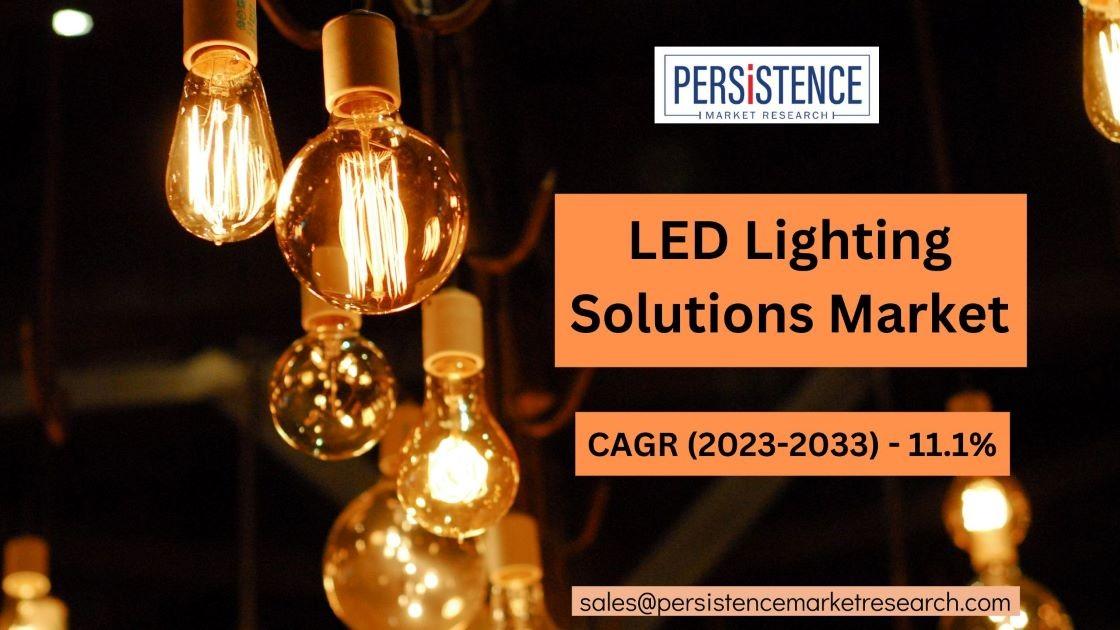LED Lighting Solutions Market: Comprehensive Segmentation Analysis
The LED lighting solutions market, valued at US$ 67,821.4 million in 2022, is poised to grow to approximately US$ 75,001.8 million by the end of 2023, projecting a compound annual growth rate (CAGR) of 11.1% from 2023 to 2033. LED lighting solutions utilize light-emitting diode technology, known for its superior energy efficiency compared to CFL and incandescent bulbs, which appeals to consumers seeking cost-effective and environmentally friendly lighting options. These solutions cater to diverse needs across industrial, infrastructure, and residential sectors, offering reduced electricity costs due to their efficiency in energy consumption and heat emission. Factors driving market growth include population expansion, urbanization, and industrial development. South Asia and the Pacific region dominated the market with a 29.1% share in 2022 and is expected to maintain its leading position. North America accounted for 21.1% of the market share in the same year.
Looking ahead, the global LED lighting solutions market is anticipated to reach US$ 237,882.4 million by 2033, fueled by increasing adoption across various sectors and regions worldwide.

Segmentation Analysis
The global LED lighting solutions market is characterized by its diverse applications across residential, commercial, industrial, and outdoor sectors, driven by technological advancements, regulatory support for energy efficiency, and increasing consumer demand for sustainable lighting alternatives. A comprehensive segmentation analysis provides insights into the market dynamics, key trends, and growth opportunities across different segments.
1. By Product Type:
LED Bulbs: LED bulbs are widely used in residential and commercial applications due to their energy efficiency, longevity, and versatility in design. They are available in various shapes, sizes, and color temperatures to suit different lighting preferences and applications.
LED Fixtures: LED fixtures encompass a wide range of lighting solutions, including recessed lighting, track lighting, panel lights, and linear fixtures. These fixtures are designed for specific applications such as office lighting, retail spaces, and architectural lighting, offering enhanced aesthetics and performance.
LED Luminaires: LED luminaires refer to integrated lighting solutions that combine LED light sources with housing, optics, and control mechanisms. They are commonly used in outdoor and industrial settings where robustness, weather resistance, and high-performance lighting are required.
2. By Application:
Residential: LED lighting solutions are extensively used in residential settings for general lighting, accent lighting, and decorative purposes. The residential segment benefits from energy savings, long lifespan, and the ability to create comfortable and inviting living spaces.
Commercial: Commercial applications include offices, retail stores, hospitality venues, and healthcare facilities, where LED lighting solutions enhance visibility, ambiance, and energy efficiency. Smart lighting systems are increasingly integrated into commercial spaces for enhanced control and operational efficiency.
Industrial: LED lighting solutions in industrial settings focus on providing high-output lighting for warehouses, manufacturing facilities, and logistics centers. These applications prioritize durability, reliability, and energy savings to optimize operational efficiency and worker safety.
Outdoor: Outdoor LED lighting solutions encompass street lighting, area lighting, architectural lighting, and landscape lighting. These applications require weather-resistant, high-performance lighting solutions that enhance visibility, security, and aesthetic appeal in public spaces and urban environments.
3. By End-User:
Government and Public Infrastructure: Governments and public authorities invest in LED lighting solutions for street lighting, public buildings, and infrastructure projects to achieve energy savings, reduce maintenance costs, and enhance public safety.
Commercial Sector: The commercial sector includes businesses, offices, retail stores, and hospitality venues that adopt LED lighting solutions to reduce operating costs, enhance customer experience, and comply with energy efficiency regulations.
Residential Sector: Homeowners and residential developers choose LED lighting solutions for energy-efficient lighting upgrades, interior design flexibility, and long-term cost savings on electricity bills and maintenance.
Industrial Sector: Industries such as manufacturing, logistics, and warehousing utilize LED lighting solutions to improve operational visibility, productivity, and safety while reducing energy consumption and maintenance downtime.
4. By Geography:
North America: North America dominates the LED lighting solutions market with strong adoption rates in the United States and Canada. The region benefits from technological innovations, regulatory support for energy efficiency, and widespread awareness of environmental sustainability.
Europe: Europe is a key market for LED lighting solutions driven by stringent energy efficiency regulations, sustainable building practices, and investments in smart city initiatives. Countries like Germany, the UK, and France lead in market adoption and technological advancements.
Asia-Pacific: The Asia-Pacific region, led by China, India, and Japan, is witnessing rapid market growth due to urbanization, infrastructure development, and government initiatives promoting energy conservation. Emerging economies in Southeast Asia are also contributing to market expansion with increasing demand for LED lighting solutions.
Middle East and Africa: The Middle East and Africa region are experiencing growing opportunities in LED lighting solutions, driven by urban development projects, infrastructure investments, and initiatives to modernize public lighting systems with energy-efficient technologies.
Future Outlook
The future of the LED lighting solutions market is promising, driven by ongoing technological innovations, regulatory support for energy efficiency, and increasing adoption across diverse applications and geographic regions. As stakeholders continue to innovate and collaborate on sustainable lighting solutions, the market is poised to expand further, revolutionizing the way we illuminate and enhance our living, working, and public environments worldwide.
